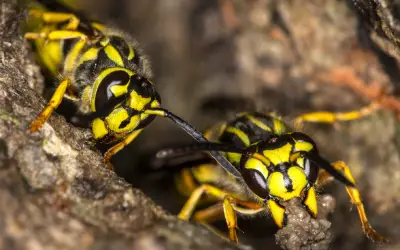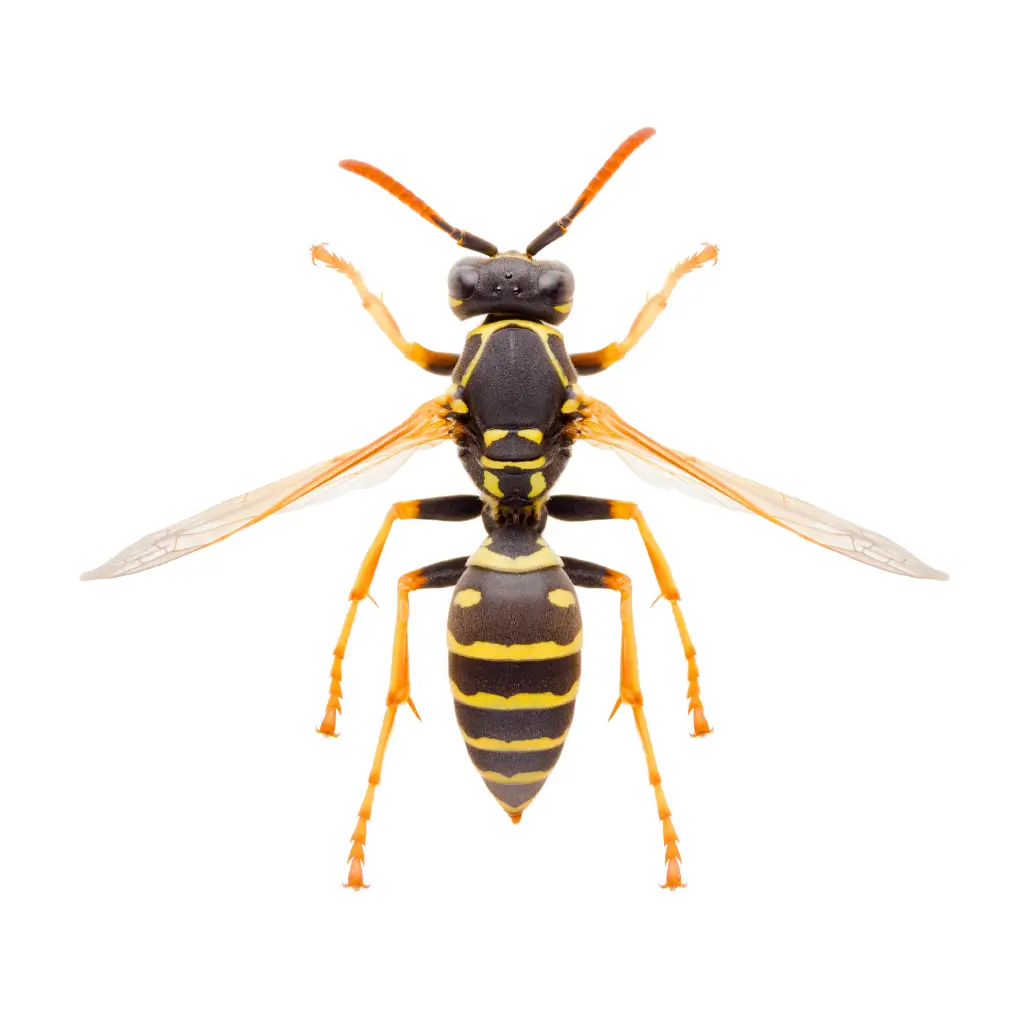
Wasps and hornets appear fearsome, but most species won’t go out of their way to attack. If they happen to sting you, it’s probably because they felt threatened. Yellowjackets, on the other hand, are just jerks sometimes. While they’re also ingrained with the instinct to protect the nest, sometimes they sting people and animals just because they want to. Their reputation for being mean and aggressive is, for the most part, well deserved. That’s why it’s important to know how to identify yellowjackets and have a plan of action in case you find them on your property
Here are the main ways to tell if you’re dealing with yellowjackets or another type of stinging insect:
- Behavior: While other types of wasps and hornets can be aggressive when threatened, yellowjackets are more aggressive naturally.
- Appearance: Yellowjackets have that classic yellow and black coloring that’s hard to miss. They also have a shorter waist section connecting their body segments, compared to other stinging insects.
- Nests: Yellowjacket nests are often buried underground or hidden in wall voids or dense shrubs.
What Should You Do If You Have Yellowjackets?
If you confirm you have yellowjackets on your property, or if you’re unable to determine for sure either way, call a professional yellowjacket exterminator for help. These insects can be extremely dangerous.
In fact, yellowjackets are much more dangerous than commonly feared animals like snakes, bears, and sharks. These large and dangerous animals only cause a small number of deaths every year, whereas stinging insects cause dozens.
Ready for pest, lawn, or sprinkler service?
Ready for qualified professionals to help keep your home, business, or lawn in pristine condition?
Schedule Your FREE Estimate!
Get your home, lawn, and lake in pristine condition. Leave your information and we'll be in touch.
*During normal business hours. After hours calls will be returned the next business day.
Explore More – How to Tell Yellowjackets Apart from Wasps and Hornets



It can be tough to tell the difference between yellowjackets and other types of wasps and hornets, especially when they’re buzzing around quickly and you’d rather not get too close. One reason why yellowjackets are tough to tell apart from wasps is that they’re a type of wasp, so it’s only natural that they share the same characteristics of other types of wasps.
It’s like asking someone to tell you the difference between a dog and a golden retriever – it’s impossible because a golden retriever is a type of dog. However, just like golden retrievers are a unique breed that’s all their own, yellowjackets have some characteristics that make them highly distinct compared to other types of wasps.
- Coloring: You might think of yellow and black as common colors for bees and wasps. They are, but yellowjackets have a uniquely vivid and pure yellow and black coloring. Other types typically have orange, reddish-brown, or white mixed in.
- Waist: Most wasps and hornets have a long and narrow waist that connects their body segments. Yellowjackets have this, but theirs is less clearly differentiated than other types.
- Nests: Paper wasps build open nests with visible combs. Hornets build large, enclosed, papery nests, often hanging off tree branches or eaves. Yellowjacket nests are more likely to be hidden – underground, in wall voids or attics, or even dense shrubs and bushes.
- Behavior: It can vary nest to nest, but typically, yellowjackets are the most aggressive species. Hornets and wasps can also be aggressive if you make them feel threatened or get too close to the nest, but yellowjackets are more likely to attack without prompting or try to scavenge off your backyard BBQ.
For more information, be sure to check out our comprehensive guide to stinging insects in Florida.
How Dangerous Are Yellowjackets?
Yellowjackets cause more serious injuries and deaths than bees, hornets, or other wasps combined due to their aggressive swarming behavior and ability to sting multiple times.
These are some of the reasons why yellowjackets are significantly more dangerous than most stinging insects:
- They can sting repeatedly without dying
- Their colonies can contain up to 5,000 aggressive workers by fall
- Yellowjacket stings cause more emergency room visits than other types of bees and wasps; they’re responsible for most wasp-related deaths in North America
- Multiple stings can cause toxic reactions even in non-allergic people
- They attack in swarms when their nest is threatened
- Their venom contains enzymes that break down tissue, causing an extensive amount of damage even if you’re not allergic.
- Yellowjackets will bite and sting – and will often bite first to gain leverage so they can administer a more powerful sting.
Should You Destroy a Yellowjacket Nest on Your Own?
Wasp insecticides are available for purchase at stores, and many people use them without issue, but it’s always a risk – and an unnecessary one. When you use these products, yellowjackets will attempt to defend their nest, so you need to make sure you eliminate them immediately. If not, they may try to attack you or anyone else nearby.
Whereas when you get help from a professional wasp exterminator, you can be sure the process is performed safely and correctly.
When You Find Yellowjackets on Your Property, Call Us for Yellowjacket Control Services
When you have yellowjackets on your property, quick action is essential, and we always recommend working with a professional yellowjacket exterminator like Sorko Services. Yellowjackets aren’t just aggressive – they’re genuinely dangerous.
If you suspect yellowjackets on your property, don’t gamble with DIY removal. The risk of a violent swarm attack isn’t worth saving a few dollars. Call us today for a safe and effective solution to your problem. Because when it comes to yellowjackets, professional removal isn’t just recommended – it’s the smart choice.
Back to Bee and Wasp ControlHow to Identify Yellowjackets and What to Do When You Find Them in Central Florida
Serving Greater Orlando, Sanford and Kissimmee
Sanford | Orlando | Poinciana | Ocala | St Cloud | Winter Garden | Clermont | DeLand | Winter Springs | New Smyrna Beach | Winter Park
Orange County | Seminole County | Lake County | Osceola County | Volusia County | Polk County | Marion County | Brevard County
Home » Bee and Wasp Control » How to Identify Yellowjackets and What to Do When You Find Them
